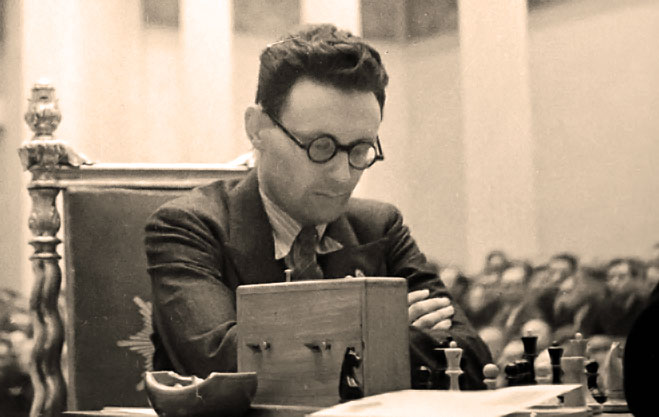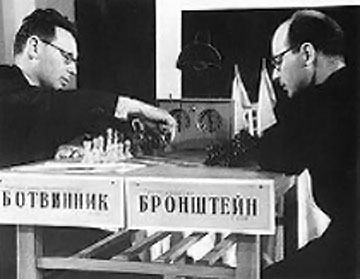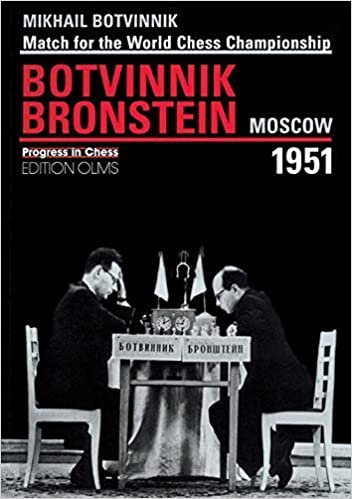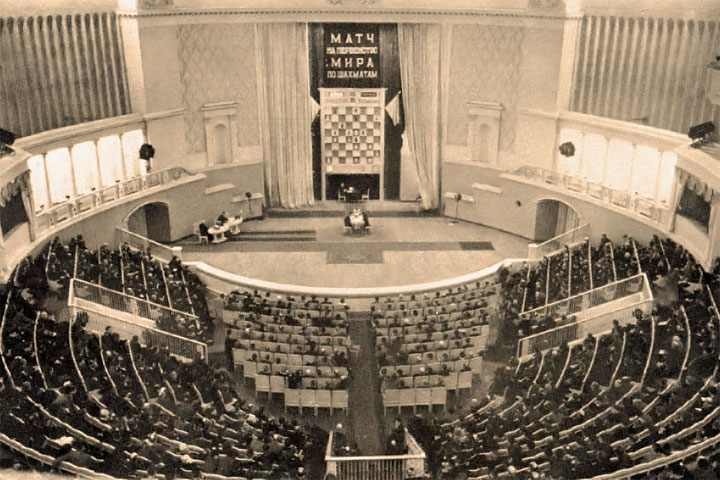The photo above was taken by William Winter and R.G. Wade during game 22. That's what a World Championship looked like in 1951 – the giant hall was packed, every seat taken.

Mikhail Botvinnik had not played a public game since he won the World Championship in 1948. The challenger was a former Ukrainian Champion (at age 15) who had shared first place in the USSR Championship in 1948 and 1949. He had won the right to play the World Champion in the Budapest Candidates 1950.


The time control was 40 moves in 2½ hours, and 16 moves an hour after that, with an adjournment to the following day after five hours of play. The winner got $5,000 and the loser $3,000, though it is rumoured that the players got considerably less.
 By game 22, Bronstein was leading 11½-10½ in the 24 game match. So he needed one point from the last two games to defeat Botvinnik. Botvinnik won the critical game 23 in what he considered one of his best games of the match. He wrote about the final move, 57. Bg5: "Zugzwang! Bronstein needed forty minutes to convince himself of the inevitability of defeat." The final game was drawn (in 22 moves) and Botvinnik retained his title.
By game 22, Bronstein was leading 11½-10½ in the 24 game match. So he needed one point from the last two games to defeat Botvinnik. Botvinnik won the critical game 23 in what he considered one of his best games of the match. He wrote about the final move, 57. Bg5: "Zugzwang! Bronstein needed forty minutes to convince himself of the inevitability of defeat." The final game was drawn (in 22 moves) and Botvinnik retained his title.
Botvinnik's book on his match against Bronstein is still available on Amazon.com – eight new copies at $43.30, ten used at $25.86. This book is 5,313,276th on the Amazon Best Seller list.
According to Garry Kasparov in On my Great Predessors II, Salo Flohr, Botvinnik's second, said he had looked at the adjourned position, and that 42.Bb1 wins. Botvinnik nodded, and they went to his room to look at some variations. Then Botvinnik said he would continue alone and asked Flohr to do the same.
Shortly before the resumption Botvinnik said to Flohr as he entered the game room: "You know, Salomonchik, I have sealed a different move." Flohr could not restrain himnself and he burst into tears... Botvinnik's suspicion went very far indeed (did he suspect possible betrayal?). In the end, however, he won.

[Event "World-ch18 Botvinnik-Bronstein +5-5=14"] [Site "Moscow"] [Date "1951.05.08"] [Round "23"] [White "Botvinnik, Mikhail"] [Black "Bronstein, David Ionovich"] [Result "1-0"] [ECO "D71"] [Annotator "Karsten Müller"] [PlyCount "113"] [EventDate "1951.03.16"] [EventType "match"] [EventRounds "24"] [EventCountry "URS"] [Source "ChessBase"] [SourceVersion "1"] [SourceVersionDate "2000.04.19"] [SourceQuality "1"] 1. d4 Nf6 2. c4 g6 3. g3 c6 4. Bg2 d5 5. cxd5 cxd5 6. Nc3 Bg7 7. Nh3 Bxh3 8. Bxh3 Nc6 9. Bg2 e6 10. e3 O-O 11. Bd2 Rc8 12. O-O Nd7 13. Ne2 Qb6 14. Bc3 Rfd8 15. Nf4 Nf6 16. Qb3 Ne4 17. Qxb6 axb6 18. Be1 Na5 19. Nd3 Bf8 20. f3 Nd6 21. Bf2 Bh6 22. Rac1 Nac4 23. Rfe1 Na5 24. Kf1 Bg7 25. g4 Nc6 26. b3 Nb5 27. Ke2 Bf8 28. a4 Nc7 29. Bg3 Na6 30. Bf1 f6 31. Red1 Na5 32. Rxc8 Rxc8 33. Rc1 Rxc1 34. Nxc1 Ba3 35. Kd1 Bxc1 36. Kxc1 Nxb3+ 37. Kc2 Na5 38. Kc3 Kf7 39. e4 f5 40. gxf5 gxf5 41. Bd3 Kg6 {[#] Everything looked good until the adjournment came. Botvinnik had sealed} 42. Bd6 {Was this adjourned move a mistake? It seems that Black can defend.} ({Botvinnik's second Flohr told him that he had looked at the adjourned position, and that} 42. Bb1 {wins. What do you think.}) 42... Nc6 43. Bb1 Kf6 44. Bg3 fxe4 45. fxe4 h6 46. Bf4 h5 47. exd5 exd5 48. h4 Nab8 49. Bg5+ Kf7 50. Bf5 Na7 51. Bf4 Nbc6 52. Bd3 Nc8 53. Be2 Kg6 54. Bd3+ Kf6 55. Be2 Kg6 56. Bf3 N6e7 57. Bg5 {So your job is: was Botvinnik's sealed move 42. Bd6 a mistake? Was the rest of game flawless? Where was Bronstein's final mistake?} 1-0
You probably know that in our replay boards there are a large number of functions you can use to really appreciate the games. Recently we published a comprehensive tutorial which tells you about all the powerful features and buttons that make the ChessBase's replay one of the best watching experiences around.
One big advantage is that you can start an engine (fan icon) that will help you to analyse. You can get multiple lines of analysis by clicking the + button to the right of the engine analysis window. The "!" key, incidentally, shows you the threat in any position, which is incredibly useful in the case of unclear moves.
 There is one more thing you can do. It is a lot of fun, but also a serious challenge: Click on the rook icon below the notation window. This will allow you the play the above position against Fritz, at your level of playing strength (e.g. "Club Player"), right here on the news page. Note that your analysis, in which you can delete, move or promote lines, is stored in the notation as new variations. In the end you will find the game with your analysis in the cloud. So nothing is ever lost.
There is one more thing you can do. It is a lot of fun, but also a serious challenge: Click on the rook icon below the notation window. This will allow you the play the above position against Fritz, at your level of playing strength (e.g. "Club Player"), right here on the news page. Note that your analysis, in which you can delete, move or promote lines, is stored in the notation as new variations. In the end you will find the game with your analysis in the cloud. So nothing is ever lost.
Please send any analysis you come up with to me at the following email address: Karsten Müller. You may also like to use more powerful engines to assist you in your efforts. Fat Fritz, for instance, goes for some unconventional continuations and surprises...I will evaluate your submissions and discuss them with you.
Links





















 By game 22, Bronstein was leading 11½-10½ in the 24 game match. So he needed one point from the last two games to defeat Botvinnik. Botvinnik won the critical game 23 in what he considered one of his best games of the match. He wrote about the final move, 57. Bg5: "Zugzwang! Bronstein needed forty minutes to convince himself of the inevitability of defeat." The final game was drawn (in 22 moves) and Botvinnik retained his title.
By game 22, Bronstein was leading 11½-10½ in the 24 game match. So he needed one point from the last two games to defeat Botvinnik. Botvinnik won the critical game 23 in what he considered one of his best games of the match. He wrote about the final move, 57. Bg5: "Zugzwang! Bronstein needed forty minutes to convince himself of the inevitability of defeat." The final game was drawn (in 22 moves) and Botvinnik retained his title.
 There is one more thing you can do. It is a lot of fun, but also a serious challenge: Click on the rook icon below the notation window. This will allow you the play the above position against Fritz, at your level of playing strength (e.g. "Club Player"), right here on the news page. Note that your analysis, in which you can delete, move or promote lines, is stored in the notation as new variations. In the end you will find the game with your analysis in the cloud. So nothing is ever lost.
There is one more thing you can do. It is a lot of fun, but also a serious challenge: Click on the rook icon below the notation window. This will allow you the play the above position against Fritz, at your level of playing strength (e.g. "Club Player"), right here on the news page. Note that your analysis, in which you can delete, move or promote lines, is stored in the notation as new variations. In the end you will find the game with your analysis in the cloud. So nothing is ever lost.




